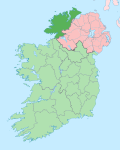This article needs additional citations for verification .(November 2009) |
Ballyness Baile an Easa | |
|---|---|
Townland | |
| Country | Ireland |
| Province | Ulster |
| County | County Donegal |

Ballyness (Irish : Baile an Easa, meaning 'townland of the waterfall') is a townland in the parish of Cloughaneely in the north west of County Donegal. Its Irish name is Baile an Easa meaning town of the waterfall. [1] It is known for its salmon fishing at the bawann pool.
